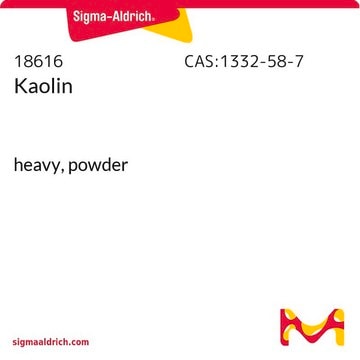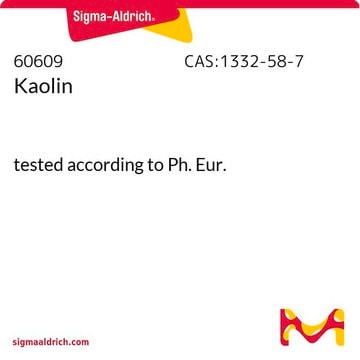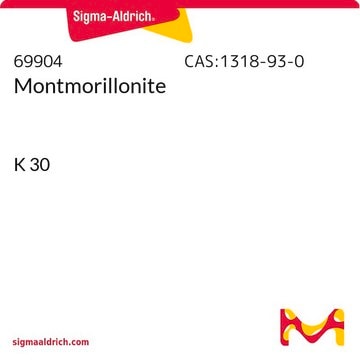Products may be shipped at a different temperature than the recommended long-term storage temperature. If the product quality is sensitive to short-term exposure to conditions other than the recommended long-term storage, it will be shipped on wet or dry-ice. If the product quality is NOT affected by short-term exposure to conditions other than the recommended long-term storage, it will be shipped at ambient temperature. As shipping routes are configured for minimum transit times, shipping at ambient temperature helps control shipping costs for our customers. For more information, please refer to the Storage and Transport Conditions document: https://www.sigmaaldrich.com/deepweb/assets/sigmaaldrich/marketing/global/documents/316/622/storage-transport-conditions-mk.pdf
About This Item
Recommended Products
form
nanopowder
Quality Level
diam. × L
30-70 nm × 1-3 μm , nanotube
surface area
64 m2/g
color
75-96, Hunter Brightness
refractive index
n20/D 1.54
pore size
1.26-1.34 mL/g pore volume
capacity
8.0 meq/g cation exchange capacity
density
2.53 (true specific gravity)
SMILES string
O.O.O[Si](O)(O[Al]=O)O[Si](O)(O)O[Al]=O
InChI
1S/2Al.H4O7Si2.2H2O.2O/c;;1-8(2,3)7-9(4,5)6;;;;/h;;1-2,4-5H;2*1H2;;/q2*+1;-2;;;;
InChI key
HEFIDAICLOZRRO-UHFFFAOYSA-N
General description
Similar to montmorillonite, halloysite consists of two layers of aluminosilicate in 1:1 Al:Si ratio.[2] Significant improvements in thermal, mechanical properties have been reported on addition of halloysite nanotubes in polymer composites. [2]
Application
Isotactic propylene-halloysite nanocomposites.[1]
Alloy composites by electroless/ autocatalytic deposition. [3]
Poly(butylene terephthalate) (PBT) composites.[4]
Zinc–halloysite nanotube (HNT) composite coatings.[5]
Halloysite nanotube–hydroxyapatite–hyaluronic acid films.[6]
Halloysite combined with polyamide, polypropylene, poly(ε-caprolactone) and fluroelastomers.[2]
Its tube like morphology, high aspect ratio, and low percolation enables interesting applications as reinforcements in nanocomposites.
Legal Information
Storage Class Code
11 - Combustible Solids
WGK
nwg
Flash Point(F)
Not applicable
Flash Point(C)
Not applicable
Personal Protective Equipment
Choose from one of the most recent versions:
Certificates of Analysis (COA)
Don't see the Right Version?
If you require a particular version, you can look up a specific certificate by the Lot or Batch number.
Already Own This Product?
Find documentation for the products that you have recently purchased in the Document Library.
Customers Also Viewed
Articles
Halloysite Nanotubes in Nanomaterials Research. Halloysite, a naturally occurring aluminosilicate nanotube, has been undeservedly forgotten.
Nanoclays like montmorillonite and bentonite are used in polymer-clay nanocomposites, rheology modifiers, and drug delivery carriers.
Nanoclays like montmorillonite and bentonite are used in polymer-clay nanocomposites, rheology modifiers, and drug delivery carriers.
Nanoclays like montmorillonite and bentonite are used in polymer-clay nanocomposites, rheology modifiers, and drug delivery carriers.
-
How is shipping temperature determined? And how is it related to the product storage temperature?
1 answer-
Helpful?
-
-
How can I determine the shelf life / expiration / retest date of this product?
1 answer-
If this product has an expiration or retest date, it will be shown on the Certificate of Analysis (COA, CofA). If there is no retest or expiration date listed on the product's COA, we do not have suitable stability data to determine a shelf life. For these products, the only date on the COA will be the release date; a retest, expiration, or use-by-date will not be displayed.
For all products, we recommend handling per defined conditions as printed in our product literature and website product descriptions. We recommend that products should be routinely inspected by customers to ensure they perform as expected.
For products without retest or expiration dates, our standard warranty of 1 year from the date of shipment is applicable.
For more information, please refer to the Product Dating Information document: https://www.sigmaaldrich.com/deepweb/assets/sigmaaldrich/marketing/global/documents/449/386/product-dating-information-mk.pdfHelpful?
-
Active Filters
Our team of scientists has experience in all areas of research including Life Science, Material Science, Chemical Synthesis, Chromatography, Analytical and many others.
Contact Technical Service












